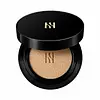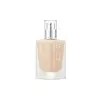What's inside
What's inside
 Key Ingredients
Key Ingredients

 Benefits
Benefits

 Concerns
Concerns

 Ingredients Side-by-side
Ingredients Side-by-side

Water
Skin ConditioningCyclopentasiloxane
EmollientMethyl Trimethicone
Skin ConditioningButylene Glycol
HumectantEthylhexyl Methoxycinnamate
UV AbsorberCI 77891
Cosmetic ColorantMica
Cosmetic ColorantCyclohexasiloxane
EmollientTrimethylsiloxysilicate
EmollientPEG-10 Dimethicone
Skin ConditioningDisteardimonium Hectorite
StabilisingCI 77947
Methyl Methacrylate Crosspolymer
Lauryl PEG-9 Polydimethylsiloxyethyl Dimethicone
Skin ConditioningDimethicone
EmollientCI 77492
Cosmetic ColorantAcrylates/Ethylhexyl Acrylate/Dimethicone Methacrylate Copolymer
Skin ConditioningAcrylates/Stearyl Acrylate/Dimethicone Methacrylate Copolymer
Sodium Chloride
MaskingAluminum Hydroxide
EmollientGlycerin
HumectantParfum
MaskingCI 77491
Cosmetic ColorantPolysorbate 40
EmulsifyingPolysilicone-11
Polysorbate 80
EmulsifyingCaprylyl Glycol
EmollientTriethoxycaprylylsilane
Lauroyl Lysine
Skin ConditioningStearic Acid
CleansingHydrogenated Lecithin
EmulsifyingPolyhydroxystearic Acid
EmulsifyingEthylhexylglycerin
Skin ConditioningCI 77499
Cosmetic ColorantDisodium EDTA
Lecithin
EmollientEthylhexyl Palmitate
EmollientIsostearic Acid
CleansingIsopropyl Palmitate
EmollientPolyglyceryl-3 Polyricinoleate
EmulsifyingWater, Cyclopentasiloxane, Methyl Trimethicone, Butylene Glycol, Ethylhexyl Methoxycinnamate, CI 77891, Mica, Cyclohexasiloxane, Trimethylsiloxysilicate, PEG-10 Dimethicone, Disteardimonium Hectorite, CI 77947, Methyl Methacrylate Crosspolymer, Lauryl PEG-9 Polydimethylsiloxyethyl Dimethicone, Dimethicone, CI 77492, Acrylates/Ethylhexyl Acrylate/Dimethicone Methacrylate Copolymer, Acrylates/Stearyl Acrylate/Dimethicone Methacrylate Copolymer, Sodium Chloride, Aluminum Hydroxide, Glycerin, Parfum, CI 77491, Polysorbate 40, Polysilicone-11, Polysorbate 80, Caprylyl Glycol, Triethoxycaprylylsilane, Lauroyl Lysine, Stearic Acid, Hydrogenated Lecithin, Polyhydroxystearic Acid, Ethylhexylglycerin, CI 77499, Disodium EDTA, Lecithin, Ethylhexyl Palmitate, Isostearic Acid, Isopropyl Palmitate, Polyglyceryl-3 Polyricinoleate
Cyclohexasiloxane
EmollientWater
Skin ConditioningTitanium Dioxide
Cosmetic ColorantDimethicone
EmollientEthylhexyl Methoxycinnamate
UV AbsorberPhenyl Trimethicone
Skin ConditioningMethyl Trimethicone
Skin ConditioningAlcohol Denat.
AntimicrobialVinyl Dimethicone/Methicone Silsesquioxane Crosspolymer
Phytosteryl/Isostearyl/Cetyl/Stearyl/Behenyl Dimer Dilinoleate
Skin ConditioningNiacinamide
SmoothingCetyl PEG/PPG-10/1 Dimethicone
EmulsifyingSynthetic Fluorphlogopite
Disteardimonium Hectorite
StabilisingMagnesium Sulfate
Butylene Glycol
HumectantPentylene Glycol
Skin ConditioningPropanediol
SolventTriethoxycaprylylsilane
Trimethylsiloxysilicate
EmollientPolyglyceryl-4 Isostearate
EmulsifyingAluminum Hydroxide
EmollientSilica Dimethyl Silylate
EmollientGlyceryl Caprylate
EmollientCaprylyl Glycol
EmollientDisodium Stearoyl Glutamate
CleansingEthylhexylglycerin
Skin ConditioningAdenosine
Skin ConditioningXylitylglucoside
HumectantAnhydroxylitol
HumectantXylitol
HumectantTocopherol
AntioxidantGlucose
HumectantParfum
MaskingCI 77492
Cosmetic ColorantCI 77491
Cosmetic ColorantCI 77499
Cosmetic ColorantCyclohexasiloxane, Water, Titanium Dioxide, Dimethicone, Ethylhexyl Methoxycinnamate, Phenyl Trimethicone, Methyl Trimethicone, Alcohol Denat., Vinyl Dimethicone/Methicone Silsesquioxane Crosspolymer, Phytosteryl/Isostearyl/Cetyl/Stearyl/Behenyl Dimer Dilinoleate, Niacinamide, Cetyl PEG/PPG-10/1 Dimethicone, Synthetic Fluorphlogopite, Disteardimonium Hectorite, Magnesium Sulfate, Butylene Glycol, Pentylene Glycol, Propanediol, Triethoxycaprylylsilane, Trimethylsiloxysilicate, Polyglyceryl-4 Isostearate, Aluminum Hydroxide, Silica Dimethyl Silylate, Glyceryl Caprylate, Caprylyl Glycol, Disodium Stearoyl Glutamate, Ethylhexylglycerin, Adenosine, Xylitylglucoside, Anhydroxylitol, Xylitol, Tocopherol, Glucose, Parfum, CI 77492, CI 77491, CI 77499
Ingredients Explained
These ingredients are found in both products.
Ingredients higher up in an ingredient list are typically present in a larger amount.
Aluminum Hydroxide is a form of aluminum. It can be naturally found in nature as the mineral gibbsite. In cosmetics, Aluminum Hydroxide is used as a colorant, pH adjuster, and absorbent.
As a colorant, Aluminum Hydroxide may add opacity, or reduce the transparency. Aluminum hydroxide is contains both basic and acidic properties.
According to manufacturers, this ingredient is an emollient and humectant. This means it helps hydrate the skin.
In medicine, this ingredient is used to help relieve heartburn and help heal ulcers.
There is currently no credible scientific evidence linking aluminum hydroxide in cosmetics to increased cancer risk.
Major health organizations allow the use of aluminum hydroxide in personal care products and have not flagged it as a carcinogenic risk at typical usage levels.
Learn more about Aluminum HydroxideButylene Glycol (or BG) is used within cosmetic products for a few different reasons:
Overall, Butylene Glycol is a safe and well-rounded ingredient that works well with other ingredients.
Though this ingredient works well with most skin types, some people with sensitive skin may experience a reaction such as allergic rashes, closed comedones, or itchiness.
Learn more about Butylene GlycolCaprylyl Glycol is a humectant and emollient, meaning it attracts and preserves moisture.
It is a common ingredient in many products, especially those designed to hydrate skin. The primary benefits are retaining moisture, skin softening, and promoting a healthy skin barrier.
Though Caprylyl Glycol is an alcohol derived from fatty acids, it is not the kind that can dry out skin.
This ingredient is also used as a preservative to extend the life of products. It has slight antimicrobial properties.
Learn more about Caprylyl GlycolCi 77491 is also hydrated iron III oxide. It's sole purpose is to give a red/pink hue to products.
Iron III oxides are classified as inorganic chemicals for coloring.
Synthetically created Ci 77491 is considered safer than those naturally found. This is because the synthetically created version may contain less impurities. Iron oxides are generally non-toxic and non-allergenic.
Learn more about CI 77491Ci 77492 is also hydrated iron III oxide. It's sole purpose is to give a yellow hue to products.
Iron III oxides are classified as inorganic chemicals for coloring.
Synthetically created Ci 77492 is considered safer than those naturally found. This is because the synthetically created version may contain less impurities. Iron oxides are generally non-toxic and non-allergenic.
Learn more about CI 77492Ci 77499 is also hydrated iron III oxide. It is created from mixing red and black iron oxides. This helps give shades of darkness to a product.
Iron III oxides are classified as inorganic chemicals for coloring.
Cyclohexasiloxane is a type of silicone more commonly known as D6. It is an emollient and solvent.
Cyclohexasiloxane is used to evenly distribute ingredients throughout the product. When applied to the skin, Cyclohexasiloxane evaporates and leaves behind a silky feel.
As an emollient, it can help the skin feel soft and hydrated. It is also used to reduce frizz in hair products.
Learn more about CyclohexasiloxaneDimethicone is a type of synthetic silicone created from natural materials such as quartz.
What it does:
Dimethicone comes in different viscosities:
Depending on the viscosity, dimethicone has different properties.
Ingredients lists don't always show which type is used, so we recommend reaching out to the brand if you have questions about the viscosity.
This ingredient is unlikely to cause irritation because it does not get absorbed into skin. However, people with silicone allergies should be careful about using this ingredient.
Note: Dimethicone may contribute to pilling. This is because it is not oil or water soluble, so pilling may occur when layered with products. When mixed with heavy oils in a formula, the outcome is also quite greasy.
Learn more about DimethiconeDisteardimonium Hectorite comes from the clay mineral named hectorite. It is used to add thickness to a product.
It can also help stabilize a product by helping to disperse other ingredients.
Hectorite is a rare, white clay mineral.
Learn more about Disteardimonium HectoriteEthylhexyl Methoxycinnamate is an organic compound that provides UVB protection. It often goes by the more common name of octinoxate. It is created from methoxycinnamic acid and 2-ethylhexanol.
Ethylhexyl Methoxycinnamate absorbs UVB rays with wavelengths between 280-320 nm. UV absorbers protect your skin by using chemical reactions to convert UV rays into heat and energy.
UVB (290-320 nm) rays emit more energy than UVA rays. They are capable of damaging DNA, causing sunburns and are thought to be linked to skin cancer.
The state of Hawaii has banned sunscreens containing octinoxate due to its potential impact on coral reefs. More research is needed to bridge gaps in this research. The European Union allows higher levels of octinoxate in sunscreens than the US and Australia.
Ethylhexyl Methoxycinnamate is oil soluble. It is not stable and may lose efficacy when exposed to sunlight.
Learn more about Ethylhexyl MethoxycinnamateEthylhexylglycerin (we can't pronounce this either) is commonly used as a preservative and skin softener. It is derived from glyceryl.
You might see Ethylhexylglycerin often paired with other preservatives such as phenoxyethanol. Ethylhexylglycerin has been found to increase the effectiveness of these other preservatives.
Methyl Trimethicone is a type of silicone. It is a solvent and emulsifier.
Solvents are used to keep ingredients together in a product. They can help dissolve ingredients to stable bases or help evenly distribute ingredients throughout the product.
Emulsifiers help stabilize a product. It does this by preventing certain ingredients from separating.
Methyl Trimethicone does not get absorbed into the skin.
Learn more about Methyl TrimethiconeParfum is a catch-all term for an ingredient or more that is used to give a scent to products.
Also called "fragrance", this ingredient can be a blend of hundreds of chemicals or plant oils. This means every product with "fragrance" or "parfum" in the ingredients list is a different mixture.
For instance, Habanolide is a proprietary trade name for a specific aroma chemical. When used as a fragrance ingredient in cosmetics, most aroma chemicals fall under the broad labeling category of “FRAGRANCE” or “PARFUM” according to EU and US regulations.
The term 'parfum' or 'fragrance' is not regulated in many countries. In many cases, it is up to the brand to define this term.
For instance, many brands choose to label themselves as "fragrance-free" because they are not using synthetic fragrances. However, their products may still contain ingredients such as essential oils that are considered a fragrance by INCI standards.
One example is Calendula flower extract. Calendula is an essential oil that still imparts a scent or 'fragrance'.
Depending on the blend, the ingredients in the mixture can cause allergies and sensitivities on the skin. Some ingredients that are known EU allergens include linalool and citronellol.
Parfum can also be used to mask or cover an unpleasant scent.
The bottom line is: not all fragrances/parfum/ingredients are created equally. If you are worried about fragrances, we recommend taking a closer look at an ingredient. And of course, we always recommend speaking with a professional.
Learn more about ParfumTriethoxycaprylylsilane is a silicone used to bind and stabilize ingredients.
As an emulsifier, it helps prevent ingredients from separating. This can help elongate the shelf life of products.
Triethoxycaprylylsilane is often used to coat mineral sunscreens ingredients to help give a better feel. It also helps reduce oxidative stress in sunscreens.
Learn more about TriethoxycaprylylsilaneThis silicone is an emollient. Emollients create a thin film on the skin to prevent moisture from escaping.
It is not soluble in water and helps increase water-resistance in products.
According to a manufacturer, it can blend seamlessly with silicone oils, such as Cyclopentasiloxane.
Learn more about TrimethylsiloxysilicateWater. It's the most common cosmetic ingredient of all. You'll usually see it at the top of ingredient lists, meaning that it makes up the largest part of the product.
So why is it so popular? Water most often acts as a solvent - this means that it helps dissolve other ingredients into the formulation.
You'll also recognize water as that liquid we all need to stay alive. If you see this, drink a glass of water. Stay hydrated!
Learn more about Water